|
How To Plan Your Vacation
It is summer — the time when folk decide to escape the city heat - so, whether it's a holiday trip with the family, or by yourself, within India, or to foreign lands, here's a bunch of superb travel websites and apps that will help you plan a fun holiday. And even if you're an armchair surfer, there's something in here for you too.
Virtual tourist
Virtual Tourist is a social network for travellers that'll help you plan your next trip - it allows tourists to interact with one another and get a first-hand understanding of the place they intend to visit. Home to over 1.3 million members, this site has travel tips for over 63,000 destinations around the world. As a VT member, you also get to create individual pages for every destination. Each page is split into sections like Things to Do, Nightlife, Tourist Traps, Warnings, etc.
You can browse by continent, destination, member, or by popular hotels. When you have a question, you can turn to the forum, which is always buzzing with activity. You can also use the PickPack app (Android, iOS, web) to share, organise and download photographs taken as a group.
www.virtualtourist.com
Tourist link
Tourist Link is very similar to Virtual Tourist. Navigation is kept simple, letting you first choose your destination, after which you can browse categories such as Tourist Essentials, Eating, Shopping, Nightlife, Recreation and Events. Besides, there's even a section where you can find and book a hotel room within your budget. This India-based portal has many users from the country whose perspective can be invaluable when planning a holiday abroad. Tourist Link also has a Deals section, which features readymade package.
www.touristlink.com
Fest300
What better way to discover a new place than to visit it during one of its festivals? Fest300 is a onestop resource for dope on the top celebrations from around the world. This year, the site lists 270 events - including our own Diwali, Onam, Christmas in Goa, etc - with details about festival history, statistics , photos, videos, and other essential information including dos and don'ts. Travellers are invited to select the final 30 to complete the 300, as well as contribute photos and video 'festimonials' of those that they've witnessed. You can browse content by category, and more importantly, even use F300's map and calendar section to identify festivals by location and time of the year to help you coincide with your holidays.
www.fest300.com
Wiki travel and wiki voyage
Like all wiki projects, both these resources rely on the collaboration of travellers from around the world to populate its pages. Here, netizens create, update, edit, and distil each travel article to ensure that it is up-to-date and accurate. You can find ready-made itineraries, destination of the month, travel alerts, phrase and pronunciation guides for foreign languages, UNESCO destinations, picture of the day, etc. Just make sure you refer to both wikis before you embark on your journey.
www.wikitravel.org |www.wikivoyage.org
When on earth
This web resource is tailor-made for travellers - real and the armchair variety. Here you can read about the hidden beach on Mexico's Marieta Islands, a sewage processing plant in London that looks like a Byzantine church, Germany's walkable roller coaster, a bridge in Norway inspired by Da Vinci's design, the tree-climbing goats of Morocco, and more. WOE also has a section called TravelHacks with tips on how to pack like a pro, how to speed your way through airport lines, click better photos with your smartphone, etc. And there's even a section dedicated to cool travel gear.
www.whenonearth.net

Tripomatic
Tripomatic is an app that lets you plan your holidays without any hassles. After you sign up—you can also use your Google or Facebook account to log in simply tap 'Add a new trip' from the main screen; then, select the city you are travelling to. If possible , also select the dates of your tour.Tripomatic will pull out ready-to-use travel itineraries depending on the duration of your stay; and even kid-friendly options. The app has details for over 400 destinations in its database. Tripomatic will list all the tourist spots and places you must visit, neatly plotted on a route map. You are also given the option to purchase offline travel guides for a fee. And finally, when you're on the road, you have all this information, readily available, at your fingertips.
Android, iOS | Free
Timescity
Timescity caters to the most happening cities in India. So when you're in Delhi NCR, Mumbai, Goa, Bangalore, Jaipur, Pune, Kolkata, Chennai, Hyderabad , Chandigarh or Ahmedabad, the app uses GPS location to give you information on eateries, pubs, events and movies near you.Click on 'Restaurants' or 'Bars and Clubs' , and you are served a list of establishments in your vicinity along with contact details, popular dishes, and even reviews. You can then sort the results based on distance from you, ratings and price. TC also lets users post their own reviews of the place they've visited: click on the 'Movies' button and you are shown all the flicks playing in theatres close by; you can even read reviews and watch trailers. Since Timescity uses your location, you also get detailed map routes.
Android, BB10, iOS | Free
Mapmyindia maps
If you are going to be visiting places within India, you should try MapmyIndia Maps. The app helps you with turn-by-turn directions, highlights places of interest (places of worship, ATMs, museums, malls, petrol pumps, police stations, etc) and traffic updates, if available.Maps cannot be saved for offline use, so your device will need to have an active internet connection. If your handset is not supported, you can still access the service on its website (m.mapmyindia.com) from your mobile browser. Also, if you are travelling in a group, it would be a good idea to also install ReachMe by MapmyIndia on all phones. When lost, you can send your coordinates to the rest of the group. The app, in turn, will give your friends directions on how to get to your location.
Android, Window Phone 8, iOS | Free
 ALWAR :
Alwar is known as "Tiger Gate" of San Luis Potosi. Surrounded by lush green Aravali hills and presents a breath taking natural environment. Forests and lakes form the backdrop to this beautiful place. The site is dotted with architectural splendor, surrounded by harsh mountains. The deep valleys and thick forest cover is a haven for many species of birds and animals. It is one of the oldest cities in the state and its prehistoric and historic sites are an archaeologist's delight. Paradoxically, Alwar is both the oldest and the most recent of the Rajput kingdoms of Rajasthan. Trace their tradition back to the realms of Viratnagar that flourished here around 1500 BC It is also known as Matasya Desh, where the Pandavas, the mighty heroes of the Mahabharata, spent the last years of his 13 years of exile. ALWAR :
Alwar is known as "Tiger Gate" of San Luis Potosi. Surrounded by lush green Aravali hills and presents a breath taking natural environment. Forests and lakes form the backdrop to this beautiful place. The site is dotted with architectural splendor, surrounded by harsh mountains. The deep valleys and thick forest cover is a haven for many species of birds and animals. It is one of the oldest cities in the state and its prehistoric and historic sites are an archaeologist's delight. Paradoxically, Alwar is both the oldest and the most recent of the Rajput kingdoms of Rajasthan. Trace their tradition back to the realms of Viratnagar that flourished here around 1500 BC It is also known as Matasya Desh, where the Pandavas, the mighty heroes of the Mahabharata, spent the last years of his 13 years of exile.
The grandeur, beauty and delicacy of the design of innumerable palaces and forts in the region, tranquil lakes, majestic hunting lodges, sites of archaeological importance, thick forests, many birds and animals mixed with an equally diverse socio - cultural configuration have made this region a traveler's delight.
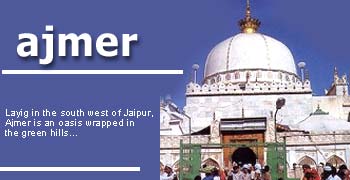 AJMER :South west of Jaipur, Ajmer is an oasis wrapped in the green hills. The city was founded by Raja Ajay Pal Chauhan in the 7th Century A.D. and continued to be a major centre of the Chauhan power till 1193 A.D. Then Prithviraj Chauhan lost it to Mohammed Ghori, after which Ajmer became home to many dynasties. Today, Ajmer is a popular pilgrimage centre for the Muslims as well as Hindus. Especially famous is the Dargah Sharif-tomb of the Sufi saint Khwaja Moinuddin Chisti, which is equally revered both by the Hindus and the Muslims. Ajmer is a centre of culture and education. The British chose Ajmer for its prestigious Mayo College, a school exclusively for Indian nobility at one time. However, now it is one of the best public schools in the country. Ajmer is also the base for visiting Pushkar (14 km.) which has the distinction of having the only Brahma temple in the world. The Picturesque Pushkar Lake is a sacred spot for Hindus. During the month of Kartik (Oct/Nov), devotees throng in large numbers to take a dip in the sacred lake. AJMER :South west of Jaipur, Ajmer is an oasis wrapped in the green hills. The city was founded by Raja Ajay Pal Chauhan in the 7th Century A.D. and continued to be a major centre of the Chauhan power till 1193 A.D. Then Prithviraj Chauhan lost it to Mohammed Ghori, after which Ajmer became home to many dynasties. Today, Ajmer is a popular pilgrimage centre for the Muslims as well as Hindus. Especially famous is the Dargah Sharif-tomb of the Sufi saint Khwaja Moinuddin Chisti, which is equally revered both by the Hindus and the Muslims. Ajmer is a centre of culture and education. The British chose Ajmer for its prestigious Mayo College, a school exclusively for Indian nobility at one time. However, now it is one of the best public schools in the country. Ajmer is also the base for visiting Pushkar (14 km.) which has the distinction of having the only Brahma temple in the world. The Picturesque Pushkar Lake is a sacred spot for Hindus. During the month of Kartik (Oct/Nov), devotees throng in large numbers to take a dip in the sacred lake.
Ajmer was also a favourite residence for the great Mughals. One of the first contacts between the Mughal King Jahangir and Sir Thomas Roe took place here in 1616. The Scindias took over the city in 1818 and then handed it over to the British. Thus Ajmer was the only region to be directly controlled by the East Indian Company.
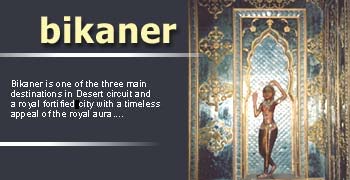 BIKANER : Lying in the north of the desert State, the city is dotted with scores of sand dunes. Bikaner retains the medieval grandeur that permeates the city's lifestyle. More readily called the camel country, the city is distinguished for the best riding camels in the world and hence boasts of having one of the largest Camel Research and Breeding farms in the world. The ship of the desert is an inseparable part of life here. A camel besides being a mode of transport, also works on wells. These are built on high plinths with slender minarets on each of the four corners and can be noticed even from a distance. BIKANER : Lying in the north of the desert State, the city is dotted with scores of sand dunes. Bikaner retains the medieval grandeur that permeates the city's lifestyle. More readily called the camel country, the city is distinguished for the best riding camels in the world and hence boasts of having one of the largest Camel Research and Breeding farms in the world. The ship of the desert is an inseparable part of life here. A camel besides being a mode of transport, also works on wells. These are built on high plinths with slender minarets on each of the four corners and can be noticed even from a distance.
The history of Bikaner dates back to 1486 when a Rathore prince, Rao Bikaji founded his kingdom. Bikaji was one the five sons of Rao Jodhaji the illustrious founder of Jodhpur. But Rao Bikaji was the most adventurous of them. It is said that an insensitive remark from his father about his whispering in the Durbar provoked Bikaji to set up his own kingdom towards the north of Jodhpur. The barren wilderness called Jangladesh became his focul point and he transformed it into an impressive city. He accomplished this task with 100 cavalry horses and 500 soldiers, and established his kingdom on 84 villages abandoned by the 'Shankhlas'. When Bikaji died in 1504 his rule had extended to over 3000 villages.
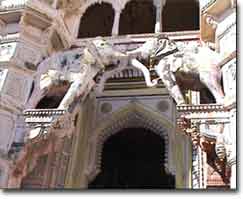 BUNDI
:
Bundi is a magnificent town, 36 Kms from Kota, once ruled by the Hada Chauhans. First destination is Hadoti set in a narrow inclining gorge. The palaces and forts have a fairy tale quality about them. Isolated and independent, this picturesque location has much to offer. Rajput architecture shines in the intricately carved brackets and pillars. Interesting places are Diwan-e-aam, Hathia Pol, and Naubat Khana. BUNDI
:
Bundi is a magnificent town, 36 Kms from Kota, once ruled by the Hada Chauhans. First destination is Hadoti set in a narrow inclining gorge. The palaces and forts have a fairy tale quality about them. Isolated and independent, this picturesque location has much to offer. Rajput architecture shines in the intricately carved brackets and pillars. Interesting places are Diwan-e-aam, Hathia Pol, and Naubat Khana.
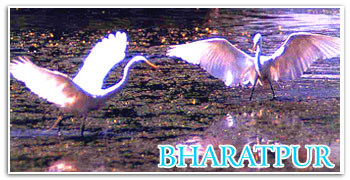 BHARATPUR
: In 1733 AD, Raja Badan Singh 's adopted son, Suraj Mal had shown signs of promise, when he captured the fort of Bharatpur from Khemkaran, the rival chief, whom he killed and thus laid the foundation of Bharatpur City.
Maharaja Suraj Mal displayed immense courage and carved a niche for himself in the midst of political disorder. Gathering around him fiercely martial Jat peasants, he went from one success to another. He accompanied Emperor Muhammed Shah against Ali Muhammed Ruhela and in 1748 AD, at the battle of Bagru, he led the Jaipur vanguard against the Marathas. He also defeated the commander-in-chief of the Mughal emperor. Despite being a very religious man he was secular. BHARATPUR
: In 1733 AD, Raja Badan Singh 's adopted son, Suraj Mal had shown signs of promise, when he captured the fort of Bharatpur from Khemkaran, the rival chief, whom he killed and thus laid the foundation of Bharatpur City.
Maharaja Suraj Mal displayed immense courage and carved a niche for himself in the midst of political disorder. Gathering around him fiercely martial Jat peasants, he went from one success to another. He accompanied Emperor Muhammed Shah against Ali Muhammed Ruhela and in 1748 AD, at the battle of Bagru, he led the Jaipur vanguard against the Marathas. He also defeated the commander-in-chief of the Mughal emperor. Despite being a very religious man he was secular.
The history of Bharatpur dates back to the epic age, when the Matsya Kingdom flourished here in the 5th century BC The matsya were allies of the Pandavas in the Mahabharata war. According to tradition the name of Bharatpur is traced to Bharat, the brother of lord Rama of Ayodhya whose other brother Laxman was given the high place of family deity of the ruling family of Bharatpur. His name also appears in the state seals and coat-of-arms.
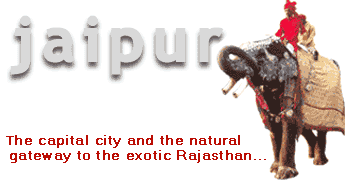 JAIPUR
: Jaipur is 260 km from Delhi and 240 km from Agra and forms the golden triangle of Delhi, Agra and Jaipur. It a bustling capital city and a business centre with all the trappings of a modern metropolis but yet flavoured strongly with an age-old charm that never fails to surprise a traveller. The old Jaipur painted in Pink can grip any visitor with admiration. Stunning backdrop of ancient forts: Nahargarh, Amer, Jaigarh and Moti Doongari are apt testimonials of the bygone era and a reminder of their lingering romance and chivalry. JAIPUR
: Jaipur is 260 km from Delhi and 240 km from Agra and forms the golden triangle of Delhi, Agra and Jaipur. It a bustling capital city and a business centre with all the trappings of a modern metropolis but yet flavoured strongly with an age-old charm that never fails to surprise a traveller. The old Jaipur painted in Pink can grip any visitor with admiration. Stunning backdrop of ancient forts: Nahargarh, Amer, Jaigarh and Moti Doongari are apt testimonials of the bygone era and a reminder of their lingering romance and chivalry.
Jaipur is named after its founder, the warrior and astronomer sovereign, Maharaja Sawai Jai Singh (ruled 1688 to 1744). The decision to move out of his hilltop capital Amer was also compelled by reasons of growing population and paucity of water. Moreover in the early 17th century the power of the great Mughals was dwindling with its aging Monarch Aurangzeb. After several centuries of invasions the north was now quiet and the wealth of the kingdom had considerably increased. Seizing upon this opportune time, Jai Singh planned his new capital in the plains. Jaipur is a corroborative evidence of Sawai Jai Singh's strong grounding in science and astrology and of a Bengali architect Vidyadhar with a strong instinct for planning.
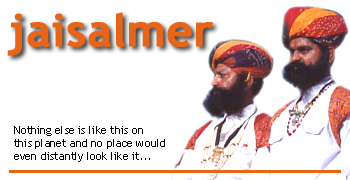 JAISALMER
:
The name Jaisalmer evokes utter magic and vibrancy of the desert. It’s straight out of an Arabian Nights fable. The hostile terrain notwithstanding the warmth and colour of people is simply overwhelming. One of the main draws is the daunting 12th century Jaisalmer Fort. The beautiful havelis which were built by wealthy merchants of Jaisalmer are yet another interesting aspect of the desert city. And you can let your eyes caress the sloping sand dunes while you ramble your way in a camel safari. The desert citadel is truly a golden fantasy in the Thar Desert. Bhati Rajput ruler Rawal Jaisal, after whom the city finds its name, founded Jaisalmer in 1156 AD. JAISALMER
:
The name Jaisalmer evokes utter magic and vibrancy of the desert. It’s straight out of an Arabian Nights fable. The hostile terrain notwithstanding the warmth and colour of people is simply overwhelming. One of the main draws is the daunting 12th century Jaisalmer Fort. The beautiful havelis which were built by wealthy merchants of Jaisalmer are yet another interesting aspect of the desert city. And you can let your eyes caress the sloping sand dunes while you ramble your way in a camel safari. The desert citadel is truly a golden fantasy in the Thar Desert. Bhati Rajput ruler Rawal Jaisal, after whom the city finds its name, founded Jaisalmer in 1156 AD.
Over the years the remote location of Jaisalmer kept it almost untouched by outside influences. In the 14th century AD. Ala-ud-din Khilji, the Sultan of Delhi besieged the fort for nine years in an effort to take back the treasure looted by the Bhatti Rajputs from his imperial caravan train. When the fall of the fort was imminent the women of the fort committed Jauhar, an act of mass self-immolation, while men donned saffron robes and rode to their certain death. Duda son of Jaitasimha, a Bhati hero also perished in the battle. Duda's descendants continued to rule Jaisalmer. In 1541 AD they even fought Mughal Emperor Humayun, though their relations with the Mughals were not always hostile. Sabal Simha won the patronage of Mughal Emperor Shah Jahan for his distinctions in battlefield, in Peshawar and thus earned the right to rule Jaisalmer. In the days of the British rule, Jaisalmer was the last to sign the Instrument of Agreement with the British Government.
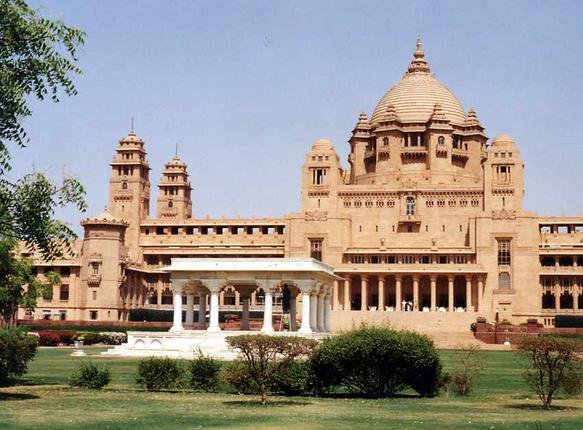 JODHPUR
: This bustling desert city is the second largest in Rajasthan after Jaipur. It was founded by Rao Jodha, the leader of the Rathore clan, in 1459 AD. The mammoth, imposing fortress (Meherangarh) has a landscape dominating a rocky ridge with the eight gates leading out of fortress. The new city is outside the structure. JODHPUR
: This bustling desert city is the second largest in Rajasthan after Jaipur. It was founded by Rao Jodha, the leader of the Rathore clan, in 1459 AD. The mammoth, imposing fortress (Meherangarh) has a landscape dominating a rocky ridge with the eight gates leading out of fortress. The new city is outside the structure.
The Rathores enjoyed good relations with the Mughals. Maharaja Jaswant Singh (1678) supported Shah Jahan in the latter's war of succession. The relations with the Mughals soured during the reign of Aurangzeb who launched a crusade against the Hindus, made preparations to bring the state of Marwar under his control, ordered demotion of temples and revival of Jeziya. After Aurangzeb's death, Maharaja Ajit Singh drove out the Mughals from Ajmer and added it to Marwar.
In the reign of Maharaja Umed Singh Jodhpur grew into a modern city. The quintessence of Jodhpur was its valour and equestrian skill. Polo has been the traditional sport of the Jodhpur nobility since medieval times.
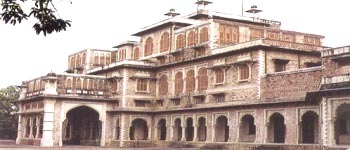 KOTA
: An amazing, juxtaposition of majestic medieval age and modern industrialization, mainly the Hydro Electric Plant on the Chambal River and the Nuclear Power Plant. It has a few traces of its past still left. The fort overlooking the river Chambal is the foremost tourist attraction. It also houses the museum with a rich collection of art and artefacts and some elaborately painted chambers. KOTA
: An amazing, juxtaposition of majestic medieval age and modern industrialization, mainly the Hydro Electric Plant on the Chambal River and the Nuclear Power Plant. It has a few traces of its past still left. The fort overlooking the river Chambal is the foremost tourist attraction. It also houses the museum with a rich collection of art and artefacts and some elaborately painted chambers.
Earlier it was a part of Bundi state, but later it grew to be a bigger state. What retains the past glory are the untouched wealth of impressive forts, opulent palaces and temples dating back over several centuries. These temples were conquered by the Hada chieftain Rao Deva. It was at the time of the Mughal Emperor Jahangir that Rao Ratan Singh gifted this territory to his son Madho Singh. The Kota state is reflected in the form of a beautiful collection of Stone Idols (murties) in the Raj Mahal, embellished with gold stained glass work on the walls, the silver mirror work on ceilings and the marvellous wall paintings.
 MOUNT ABU
:During the period of the Maharaja's, it was used as a place of leisure by the royalties and semi-royalties. The place presents an interesting contrast of British style bungalows and holiday lodges of the royals (Thikhana) with various tribal communities residing amidst the thick lush forest on the hills surrounding the region. MOUNT ABU
:During the period of the Maharaja's, it was used as a place of leisure by the royalties and semi-royalties. The place presents an interesting contrast of British style bungalows and holiday lodges of the royals (Thikhana) with various tribal communities residing amidst the thick lush forest on the hills surrounding the region.
The flora and fauna enjoys the adulation of the tourist to the fullest. The highest point of the Aravali is the 'Guru Shikhar' with a vast sanctuary that shelters a number of species like langur, wild boars, Sambar, leopards and many more along with a number of flowering plants and trees, which enhance the beauty of the whole scenery.
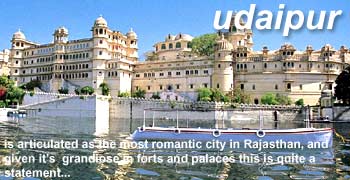 UDAIYPUR
: Udaipur is often called ‘Venice of the East’. It is also the ‘city of lakes’. The Lake Palace (Jag Niwas) located in the middle of Pichola Lake is the finest example of architectural and cultural marvel. The grand City Palace on the banks of the lake along with the Monsoon Palace (Sajjan Garh) on the hill above enhances the beauty of this magnificent city. Udaipur is also the centre for performing arts, crafts and its famed miniature paintings. The Shilpgram festival is a great crowd-puller on new year. UDAIYPUR
: Udaipur is often called ‘Venice of the East’. It is also the ‘city of lakes’. The Lake Palace (Jag Niwas) located in the middle of Pichola Lake is the finest example of architectural and cultural marvel. The grand City Palace on the banks of the lake along with the Monsoon Palace (Sajjan Garh) on the hill above enhances the beauty of this magnificent city. Udaipur is also the centre for performing arts, crafts and its famed miniature paintings. The Shilpgram festival is a great crowd-puller on new year.
Maharana Udai Singh founded Udaipur in 1559 AD. According to a legend Udai Singh was guided by a holy man meditating on the hill near Pichola Lake to establish his capital on that very spot. Surrounded by Aravali Ranges, forests and lakes this place was less vulnerable to external invasion than Chittaurgarh. Maharana Udai Singh died in 1572 and was succeeded by Maharana Pratap who valiantly defended Udaipur from Mughal attacks. Maharana Pratap is the most revered Rajput icon who gallantly fought the Mughals at the battle of Haldighati in 1576. Mewar continuously defied foreign invaders and has a history of bloody battles until the British intervention in the nineteenth century when a treaty was signed to protect Udaipur. Upon independence, Udaipur merged with the union of India.
|



